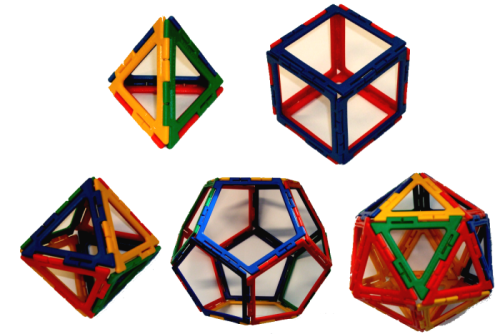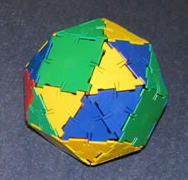Or search by topic
Number and algebra
Geometry and measure
Probability and statistics
Working mathematically
Advanced mathematics
For younger learners
Which Solids Can We Make?



Which Solids Can We Make printable sheet
Which Solids Can We Make printable sheet - extension
This problem follows on from Semi-regular Tessellations.
Here are pictures of the five Platonic Solids - solids made from just one type of polygon, with the same number of polygons meeting at each vertex:
tetrahedron, cube, octahedron, dodecahedron, icosahedron

Can you convince yourself that there are no more?
The angle deficit at a vertex of a polyhedron is a measure of how far short each angle sum is from $360^{\circ}$.
For example, in a dodecahedron, three pentagons with interior angles of $108^{\circ}$ meet at each vertex, so the angle sum is $324^{\circ}$ and the angle deficit is $36^{\circ}$:

Archimedean Solids have two properties:
- They are formed by two or more types of regular polygons, each with the same side length
- Each vertex has the same pattern of polygons around it.
Here is a picture of an Archimedean Solid with 24 vertices. Its vertex form {3, 3, 3, 3, 4} is defined by the polygons that meet at each vertex: triangle, triangle, triangle, triangle, square.

Calculate the total angle deficit for this solid. Does it match your observations about the Platonic solids?
Try to suggest some other vertex forms which might give rise to Archimedean solids, assuming all solids share the property you have discovered. If you have access to construction sets such as Polydron, you could test out your ideas.
Below are some vertex forms you might like to try: some of them give rise to solids and some of them don't. Can you decide which will work before testing them out?

You may also like
A Mean Tetrahedron
Can you number the vertices, edges and faces of a tetrahedron so that the number on each edge is the mean of the numbers on the adjacent vertices and the mean of the numbers on the adjacent faces?
Rhombicubocts
Each of these solids is made up with 3 squares and a triangle around each vertex. Each has a total of 18 square faces and 8 faces that are equilateral triangles. How many faces, edges and vertices does each solid have?
Icosian Game
This problem is about investigating whether it is possible to start at one vertex of a platonic solid and visit every other vertex once only returning to the vertex you started at.

